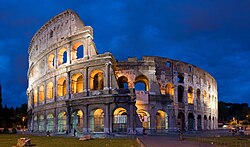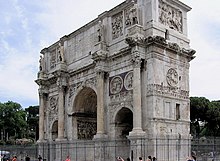Monument: Difference between revisions
No edit summary |
|||
| Line 69: | Line 69: | ||
==External links== |
==External links== |
||
* [http://pmsa.cch.kcl.ac.uk/index.htm Website of Monuments and Sculptures in UK] |
* [http://pmsa.cch.kcl.ac.uk/index.htm Website of Monuments and Sculptures in UK] |
||
* [http://www.statuemap.com StatueMap.com] - put your Statue on the Map! |
|||
[[Category:Monuments and memorials| ]] |
[[Category:Monuments and memorials| ]] |
||
Revision as of 12:59, 28 January 2008

A monument is a statue, building, or other edifice created to commemorate a person, event or as an artistic object. They are frequently used to improve the appearance of a city or location. Cities that are planned such as Washington D.C., New Delhi and Brasília are often built around monuments. The Washington Monument's location (and vertical geometry, though not physical detail) was conceived to help organize public space in the city before it was ever connected with George Washington. Older cities have monuments placed at locations that are already important or are sometimes redesigned to focus on one. As Shelley suggested in his famous poem "Ozymandias" ("Look on my works, ye Mighty, and despair!"), the purpose of monuments is very often to impress or awe. In English the word "monumental" is often used in reference to something of extraordinary size and power. The word comes from the Latin "monere," which means 'to remind' or 'to warn.'
Functional structures made notable by their age, size or historic significance can also be regarded as monuments. This can happen because of great age and size, as in the case of the Great Wall of China, or because an event of great import occurred there such as the village of Oradour-sur-Glane in France.

Monuments are also often designed to convey historical or political information. They can be used to reinforce the primacy of contemporary political power, such as the column of Trajan or the numerous statues of Lenin in the Soviet Union. They can be used to educate the populace about important events or figures from the past, such as in the renaming of the old General Post Office Building in New York City to the James A. Farley Building (James Farley Post Office), after former Postmaster General James Farley.
Monuments have been created for thousands of years, and they are often the most durable and famous symbols of ancient civilizations. The Egyptian Pyramids, the Greek Parthenon, and the Moai of Easter Island have become symbols of their civilizations. In more recent times, monumental structures such as the Statue of Liberty and Eiffel Tower have become iconic emblems of modern nation-states. The term monumentality relates to the symbolic status and physical presence of a monument.
Until recently, it was customary for archaeologists to study large monuments and pay less attention to the everyday lives of the societies that created them. New ideas about what constitutes the archaeological record have revealed that certain legislative and theoretical approaches to the subject are too focused on earlier definitions of monuments. An example has been the United Kingdom's Scheduled Ancient Monument laws.
Famous Monuments
Brazil

- Carioca Aqueduct, Rio de Janeiro
- Cristo Redentor, Rio de Janeiro
- Quinta da Boa Vista, Rio de Janeiro
- MAC (Museu de Arte Contemporânea), Niterói
- Cantareira Station, Niterói
- National Congress of Brazil, Brasília
Portugal
France

Italy
Types of monuments
- Buildings designed as iconic landmarks
- Church monuments to commemorate the dead, above or near their grave, often featuring an effigy
- Cenotaphs and memorials to commemorate the dead, usually war casualties - e.g. Vimy Ridge Memorial and India Gate
- Columns, often topped with a statue - e.g. Nelson's Column in London
- Grave stones constitute small monuments to a dead person
- Mausoleums and tombs to inter the dead - e.g. the Great Pyramid and Taj Mahal
- Monoliths erected for religious or commemorative purposes - e.g. Stonehenge
- Obelisks usually erected to commemorate great leaders - e.g. the Washington Monument
- Statues of a famous individual or as a symbol - e.g. Statue of Liberty
- Triumphal arches, almost always to commemorate military successes - e.g. the Arc de Triomphe
- Entire areas can also be used as memorials, usually to commemorate wartime atrocities or notably bloody battles - e.g. Oradour-sur-Glane or the battlefields at Gettysburg, Pennsylvania and Borodino.
- On occasion, areas of special natural beauty are also referred to as monuments.

See also
- Seven Wonders of the World
- Monument Valley
- Terminating vista
- Monument tube station and Monument to the Great Fire of London
- Monument Avenue (Richmond, Virginia)
- List of monuments in the United States
- Papahānaumokuākea Marine National Monument (the newest and largest marine protected area in the world)
External links
- Website of Monuments and Sculptures in UK
- StatueMap.com - put your Statue on the Map!
